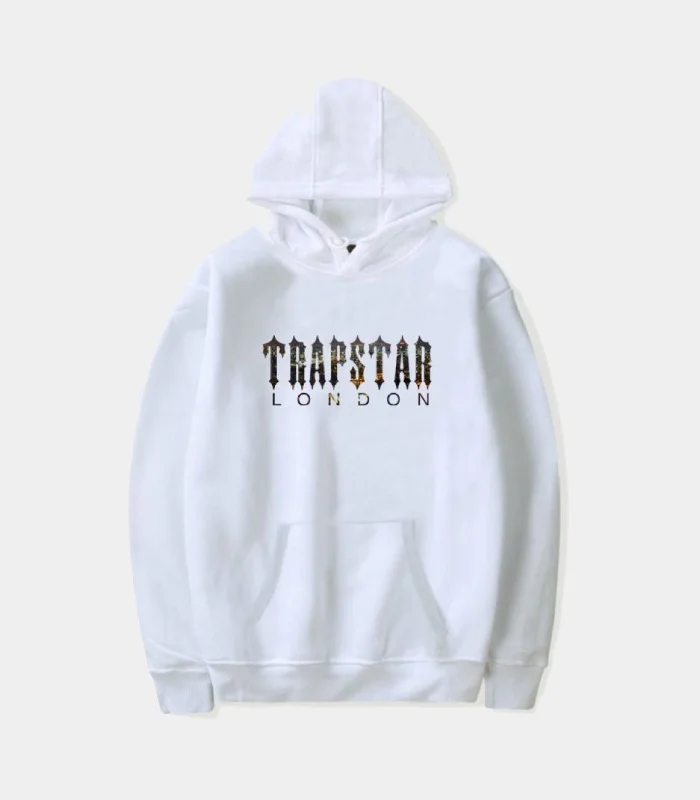The Streets Speak First: Trapstar’s Humble Origins
Before Trapstar was an international fashion statement, it was a whisper in the streets of West London. Born in the early 2000s out of the minds of friends Mikey, Lee, and Will, Trapstar began as a guerrilla-style, underground brand. It was never about boardrooms, marketing plans, or investor decks. It was about survival, expression, and sending messages through clothing that only those “in the know” could decode. Their first tees were made in bedrooms and sold out of car trunks — a literal translation of street hustle into wearable hustle.
The name “Trapstar” itself blends the grit of “trap” culture — the hustle, the grind, the reality of street life — with the aspiration and shine of a “star.” That duality is what drives the brand’s DNA: raw, unfiltered edge wrapped in undeniable ambition.
Code Red: The Signature Style That Spoke Volumes
Trapstar isn’t just about fashion — it’s about coded rebellion. The brand’s most iconic symbol, the red “It’s A Secret” tag, says everything and nothing at once. It’s a dare. It’s a statement. It’s a question. And for those who wear it, it’s a badge of belonging.
Design-wise, Trapstar quickly became synonymous with dark color palettes, heavy-duty streetwear silhouettes, bold Gothic fonts, and cryptic graphics. Their hoodies, jackets, and tracksuits walk the line between militaristic utility and London grime elegance — a look that’s both ready for the roads and ready for the runway. You don’t wear Trapstar to blend in; you wear it to claim space.
The Celebrity Co-Sign: From the Block to the Booth
One of Trapstar’s greatest power moves was letting the culture speak for itself. Instead of chasing celebrities, the brand let artists, athletes, and icons come to them. And they did — in waves.
Rihanna, A$AP Rocky, Travis Scott, and The Weeknd were early adopters. In the UK, grime heavyweights like Skepta, Stormzy, and Giggs championed the label, merging music and fashion into a new kind of street gospel. These weren’t random endorsements — they were cultural affirmations. Trapstar wasn’t riding the wave; it was the wave.
And perhaps most importantly, it caught the eye of Jay-Z, who through Roc Nation helped launch Trapstar into international markets. That co-sign elevated the brand from streetwear niche to a force on the global fashion radar.
Collaboration as Weapon: Trapstar’s Strategic Moves
Trapstar knew the rules of streetwear success: Collaborate or get left behind. But rather than chase hype, they built partnerships that fit their DNA.
Their long-standing collaboration with Puma fused performance wear with street aesthetics, resulting in sold-out capsule drops that maintained authenticity. Other partnerships, like with the “Call of Duty” video game franchise, allowed them to reach new audiences while sticking to their rebellious spirit.
Trapstar doesn’t dilute — it expands. Every collaboration is less about branding and more about creating a lifestyle link, a story told across mediums, cultures, and continents.
Trapstar in the Fashion Big Leagues: The Billboard Era
The rise from blocks to billboards wasn’t just poetic — it was literal. Trapstar’s marketing evolved from whispered street code to full-scale takeovers, like the viral campaign of their “It’s A Secret” slogan plastered across London buses, digital billboards, and high-traffic urban areas.
It wasn’t just about selling clothes — it was about marking territory. When Trapstar hit Selfridges and online retailers like END., the message was clear: this wasn’t just a street brand anymore — it was a luxury lifestyle, rooted in rebellion.
Despite its wider availability, Trapstar never lost its mystique. It managed to scale without selling out, maintaining the same energy, the same edge, and the same exclusivity that built its cult following.
Global Footprint, Local Roots
Even as Trapstar took over stores in Tokyo, New York, and Paris, it never forgot where it came from. The brand still draws visual inspiration from London’s street signage, public transport typography, and the graffiti-laced grit of the boroughs that raised it.
Trapstar’s authenticity lies in its refusal to sanitize the street. The garments still speak a coded language, designed for those who know — but admired by those who want to learn. That tension between insider culture and outsider curiosity has helped keep Trapstar both fresh and familiar, no matter where it’s worn.
Fashion with a Message: Trapstar’s Cultural Voice
Trapstar is more than aesthetics — it’s political. It speaks to a generation that understands style as armor, as protest, as self-definition. It reflects the realities of Black British youth, the struggles of working-class identity, and the power of making noise without saying a word.
In a time where fashion is increasingly performative, Trapstar’s refusal to explain itself — “It’s A Secret” — becomes its loudest scream. It’s anti-establishment without being preachy, militant without needing a manifesto.
This isn’t fast fashion. It’s movement-wear.
The Future Is Guarded — But Growing
Trapstar’s future remains purposefully unpredictable. That’s the genius. Even as it partners with global brands and occupies luxury retail spaces, it doesn’t flood the market. Each drop feels like a signal. Each piece is limited, guarded, almost ceremonial.
That scarcity fuels the myth, and the myth fuels the movement.
What’s next? Expansion is inevitable — maybe more flagship stores, more worldwide collaborations, and possibly dipping into digital fashion or metaverse wear. But if Trapstar’s journey so far has taught us anything, it’s that they’ll move on their own terms.
Conclusion: A Brand That Hustled Its Way to the Top
From selling T-shirts out of boot trunks in West https://trapstar.it.com/
London to taking over international fashion headlines, Trapstar’s journey isn’t just impressive — it’s emblematic of a new era in streetwear. One where the streets set the tone, and the billboards follow.
It didn’t ask for attention. It took it.
It didn’t cater to everyone. It created for the culture.
And it didn’t follow fashion. It made fashion follow it.
That’s the Trapstar takeover — not just a rise, but a reign.

















